Things to do
How to Attend a Vodou Ceremony in Haiti
A Vodou ceremony
Photo: Pierre Michel Jean
Skulls, sequins and gunpowder smoke - here’s a glimpse inside a modern Haitian vodou ceremony. Find out how to attend and what to expect.
Share
There’s no doubt that Vodou is a powerful spiritual tradition. The world’s first free black republic was formed, at least in part, thanks to the uniting spirit of Vodou. Vodou was the common thread that united leaders in the Haitian revolution, despite their lack of a common language, tribal bonds or country of origin. In the space of just a few years, in a seemingly miraculous feat against the odds, an army of slaves threw off their chains, overthrew the French colonial government, beat Napolean’s navy, abolished slavery, and formed modern Haiti.
Today, perhaps not despite but because of these powerful roots, Vodou may just be the most maligned, feared and misunderstood spiritual tradition in the western world. It’s time to set the records straight. Perhaps the best way to help celebrate the freedom fighters and dispel the myths is to attend a Vodou ceremony in Haiti and see for yourself.
Here’s how.
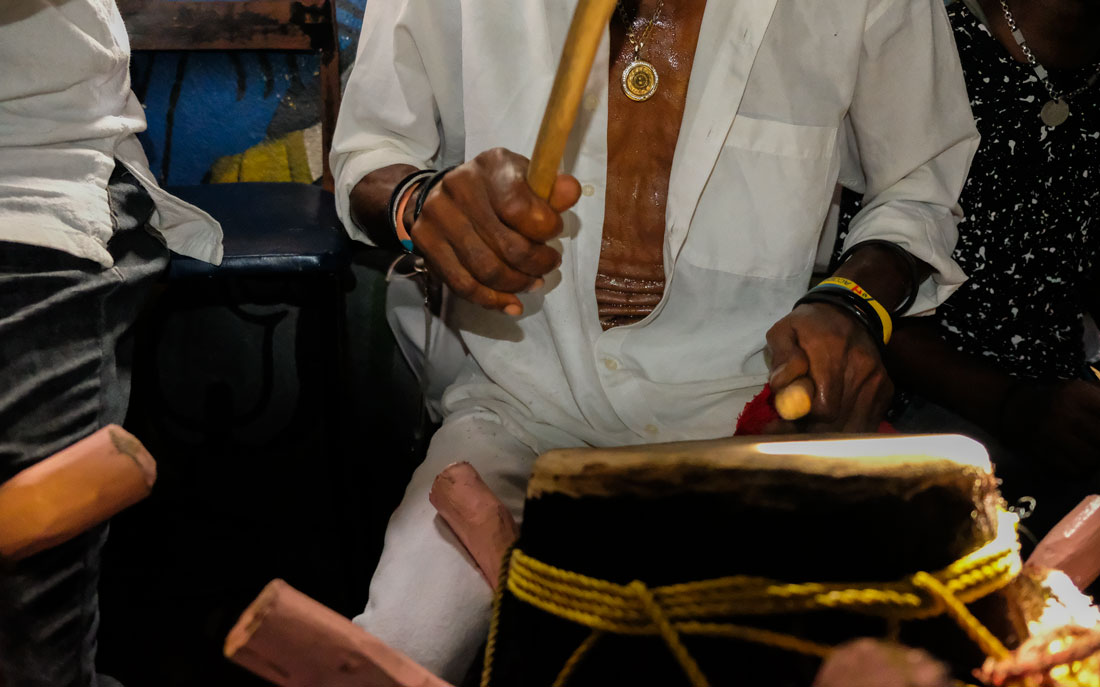
A drummer at a Vodou ceremony
Photo: Franck Fontain
Find out about a Vodou dans
Sacred Vodou gatherings can be called by many names, most often a ceremony, ritual or dance. In Haitian Kreyòl, Vodou practitioners often refer to the event as a dance (dans). The terms dance and ceremony will be used interchangeably for the purposes of this guide.
Find out ahead of time who and what the dance will be for
It may be helpful to ask who the dance will be for and what purpose, if any, is intended. For example, is there a specific lwa (spirit) being evoked? If the ceremony takes place in early November, it will likely be held in honor of the Gede lwa and Day of the Dead. Remember that Petwo deities are the fiery, offense-oriented counterpart of the gentler, protective Rada deities. This can help anticipate the tone of the ritual.
If this is your first time attending a Vodou ceremony, it is recommended to attend a Rada dance, not least because you’re less likely to see animal sacrifice. For example, you could attend a springtime dance held to usher in a season of abundant harvest, good luck and good health. You may wish to begin with a Rada dance for Erzulie Freda, the goddess of love and sensuality, or La Sirène, the mermaid goddess of good luck, fertility and material abundance.
The rites, devotions and overall style of ceremony will vary greatly depending on which part of Haiti you are attending the dance in. For example, Papa Legba and the twin spirits known as Marassa are all recognized through particular rites with certain rituals, dances, drum rhythms, offerings, prayers and cosmograms drawn on the ground. But the specific interpretations of a Legba or Marassa dance in Cap-Haïtien will vary from one held in Jacmel. This is true for all rites and rituals across the different Vodou temples in Haiti.
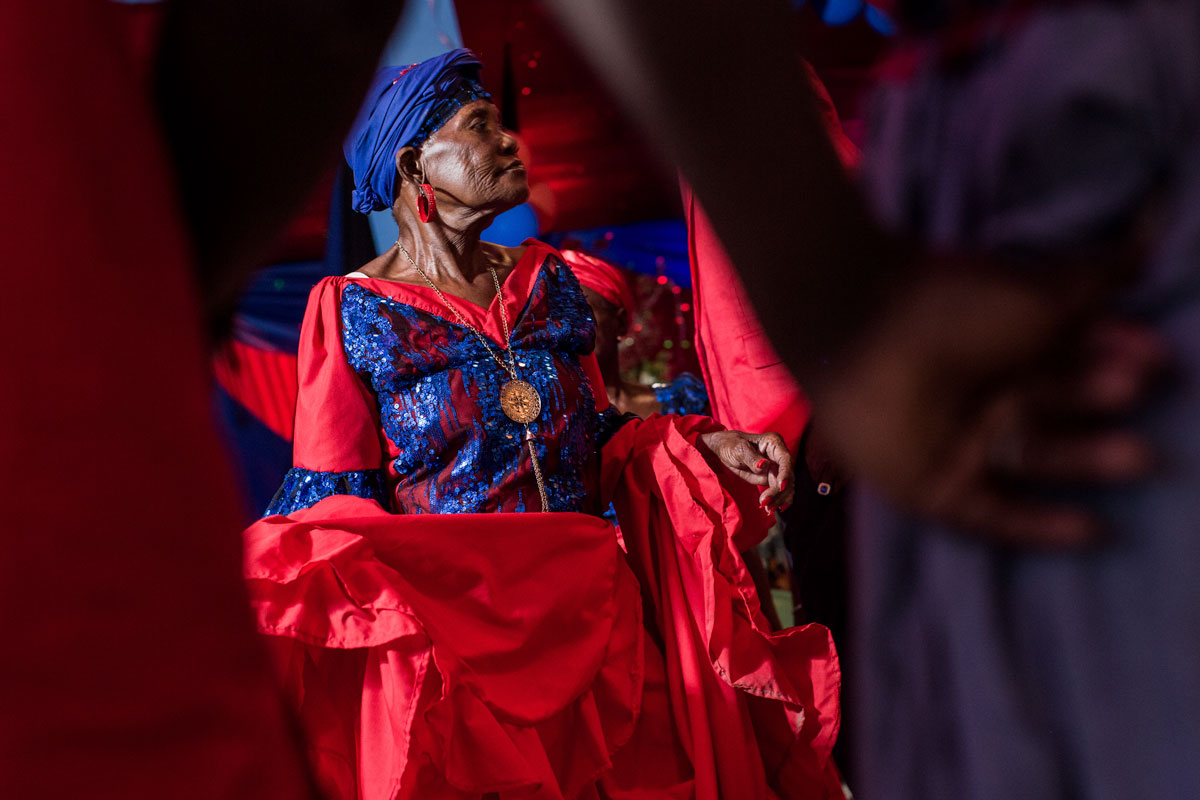
A woman at a Vodou Ceremony
Photo: Pierre Michel Jean
Expect to be there a while
A Vodou dance can last a long time. In Jacmel for example, the rum-fuelled drummers that launch a ceremony at dusk can be found still drumming at dawn - albeit with swollen and bruised hands. So like any dance you attend in a foreign city, bring plenty of water and relax expectations of a set time for when it will end. If you want an exit strategy mid-dance, go with someone who you trust will be flexible to go when you are ready, pay your respects to the host who invited you if possible, and you can simply leave when you’re ready.
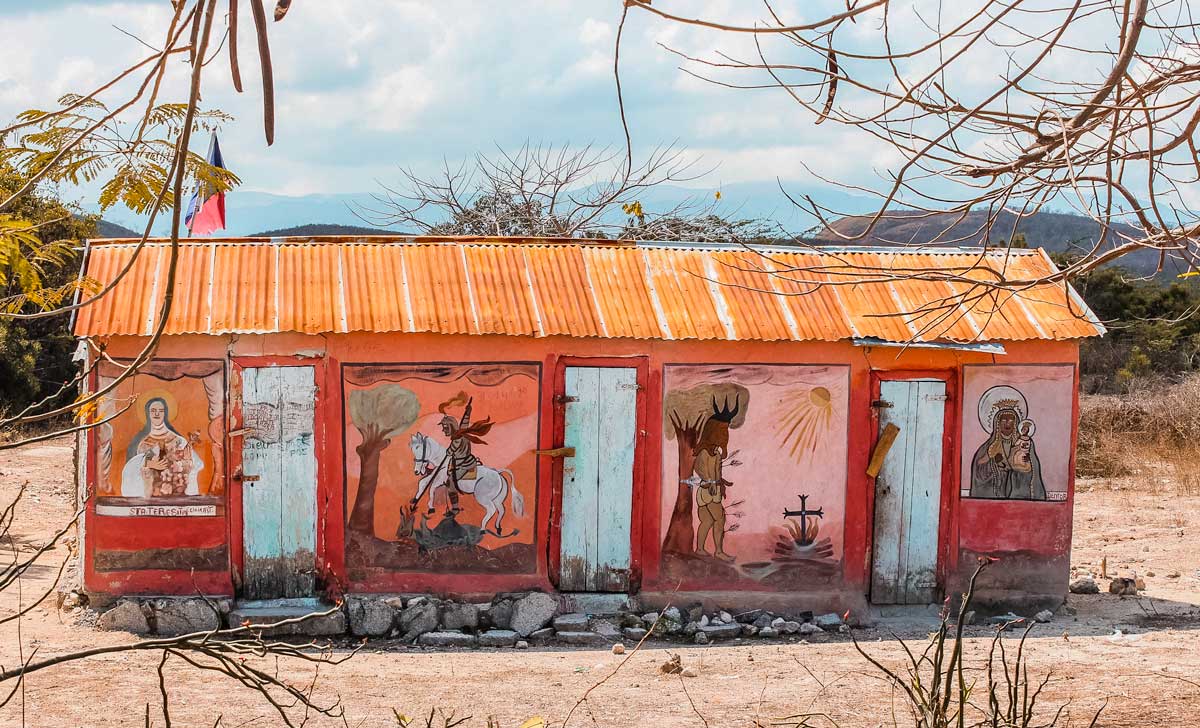
Vodou peristyle in Artibonite
Photo: Emily Bauman / Amanacer
What a vodou temple looks like
Vodou dances take place at a peristil: a temple, usually round, always with a pole in the center called the central pole (poto mitan) representing the navel of the universe. Many Vodou temples in Haiti are indoor-outdoor, while others are fully enclosed or completely open to the sky. Some sacred rituals take place at waterfalls like Sodo or near a sacred mapou tree, but for the purposes of this guide, we will assume you will attend a ceremony at a peristil.
At the center of the ceremonial space, you’ll see an altar. Bottles represent gifts and offerings. Machetes are symbols of honor and respect to entities in the spirit world.
Check your cultural baggage at the door
On the altar, you may also see skulls and other human remains. While the western world associates bones with death, necromancy and spooky halloween kitsch, it is important to know that skulls hold nearly the opposite significance in Vodou. Try looking at the skull and seeing the comforting presence of an ancestor, or the balance between life and death.
While western cultures tend to avoid death and displace it from the family home, keeping the dead close is a crucial part of cultures from Romania to Indonesia to Haiti. In Vodou, death is not to be hidden from daily life, but embraced in ceremonies as a way to more fully appreciate and celebrate life.
Ancestors and dead family members may be called on to join the dance. Those who have passed away come among the community once more to offer advice, and take part in the rituals. Rather than framing this as a haunting, think of it as a glorious family reunion.
When attending a Vodou ceremony it is a good idea to approach the experience with a blank slate, and a relaxed, open mind, ready to learn. Check your cultural baggage at the door and enjoy the ride of a totally new experience!
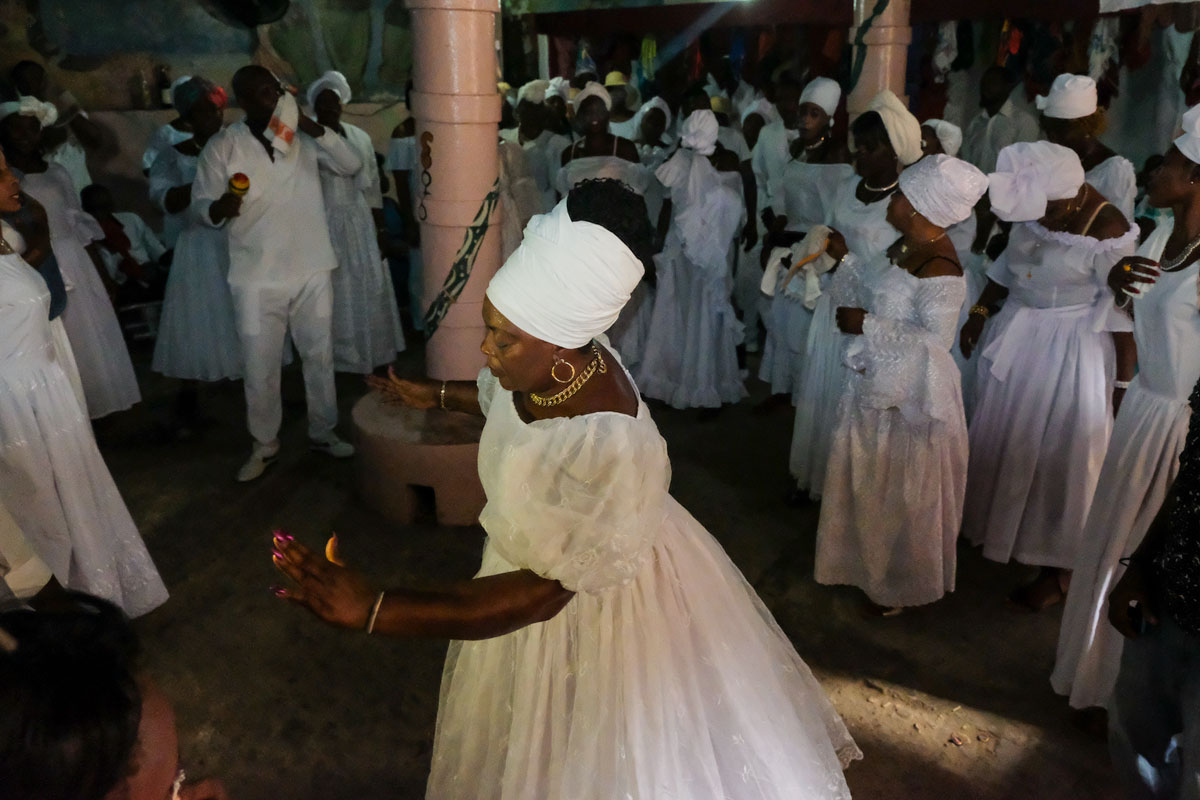
Dancing at a Vodou ceremony
Photo: Franck Fontain
Wear something nice, but not white!
What you wear matters! Business casual attire is appropriate. Avoid loud T-shirts or anything ratty or worn out. Men can dress in jeans and a short sleeve button-up shirt, and women jeans and a blouse. Aim for fancy but respectful clothing, and no lavish jewelry. Rural dances will generally be more casual.
Color is a key consideration. The purity of white is highly significant at the dance and is reserved for Vodou practitioners, so it’s best not to wear white to any Vodou ritual. Patterns and colors are acceptable - but be careful with colorful head scarves! Keep reading to find out why.
It’s helpful to remember that Haiti can be remarkably hot at nearly any time of year and even sometimes at night. Linen and cotton are your best friend, regardless of whether you plan to attend a ceremony in a city or rural environment.
Bring an offering
While a Vodou dance is no dinner party, it is appropriate to bring an offering of alcohol. Wine is not the hostess’ beverage of choice in this case. Ask if you can offer a liter or half gallon of unrefined rum, called kleren. You can buy it locally and inexpensively almost everywhere in Haiti, but the gesture is important and will be valued, particularly in rural settings. Kleren is the fuel of many Vodou dances, offered to the spirits and the sèvitè (servants of the spirits) alike. The drummers - who often play all night and into the dawn - will be especially appreciative.

A ougan at a Vodou ceremony
Photo: Pierre Michel Jean
Beginning the dance
A series of prayers, sometimes Roman Catholic in origin, begin the ceremony. Vodou spirits who serve as gatekeepers are saluted with appropriate honors, offerings, and invocations. If invoking the fiery Petwo lwa, voudiwizans might use whip-cracks, whistles, gasoline and even lit gunpowder to get their attention.
Who leads the dance?
You will be able to identify the Vodou initiates (the men and women who will orchestrate the ceremony) by their all-white ceremonial garb. Most initiates wear traditional Haitian skirts in white, starched white blouses and a white handkerchief on the head. Some may wear colorful satin headwraps. The color of the headwrap is associated with the lwa being served that day, but it also indicates rank in the temple hierarchy.
Mambo or manbo is the name for a female Vodou priestess. Ougan is the name for a male Vodou priest. Mambo and ougan are figures of great authority and respect in the community, responsible for intervening in a wide range of societal hardships, from illness to family conflict, financial trouble or even just a string of bad luck. As intermediaries between the lwa and humans, they act as servants who restore health, harmony and balance.
Drumming is believed to create a passageway to the spirit world. It’s a rhythmic invitation to the lwa to attend the dance being held in his or her honor. Much like a radio station, when the drummers tune into the specific FM frequency of the lwa, it begins to broadcast on that channel. Each lwa has their own drum rhythm and associated dances, and there can be variations between traditions, as well - a Dahomey-descended drum rhythm is different from a Congo-descended drum rhythm. Initiates can spend lifetimes perfecting their repertoire.

A vèvè being drawn on the floor of a hounfour
Photo: Pierre Michel Jean
Vèvè cosmograms
Towards the beginning of the dance, initiated Vodou practitioners will trace a vèvè cosmogram on the floor with white powder. This takes immense skill, precision and training. These symmetrical vèvè are ancient and unique to each lwa.
Once it is traced in perfect symmetry on the floor of the temple, an essential element is in place permitting the lwa to descend. Like the unique drum rhythms, the unique cosmograms are call signs, drawing down a particular lwa. As well as the precisely-drawn vèvè on the ground, a sequined flag depicting the cosmogram is hung in a place of honor for all to see.
Learn more about the intricate art of Vodou symbols with our visual guide to the vèvè of Haitian Vodou.
Possession Trances
If the dance is a success, expect to see a possession trance. In creole the person possessed is known as the chwal (horse) that will be “ridden” by the lwa. Here’s how to identify a chwal:
You may see people with pupils dilated, people with spasmodic behaviour, seemingly out of control of their bodies doing the impossible like walking over flaming hot coals. There is no need to be alarmed when people give their bodies over to the lwa to be directed in this way. It means the ceremony is a success, and it represents a culmination of complex rites and practices that have survived hundreds of years of repression.
The trance is an opportunity for the spirit to perform healing through the possessed chwal. Blessings may take place, and it’s also a chance for the lwa to rebuke those in the community who need to smarten up and change their ways.
The possession trance may last for just a few minutes or for several hours. The chwal who has given his or her body in service to the lwa will most likely wake up exhausted, not remembering what has transpired.
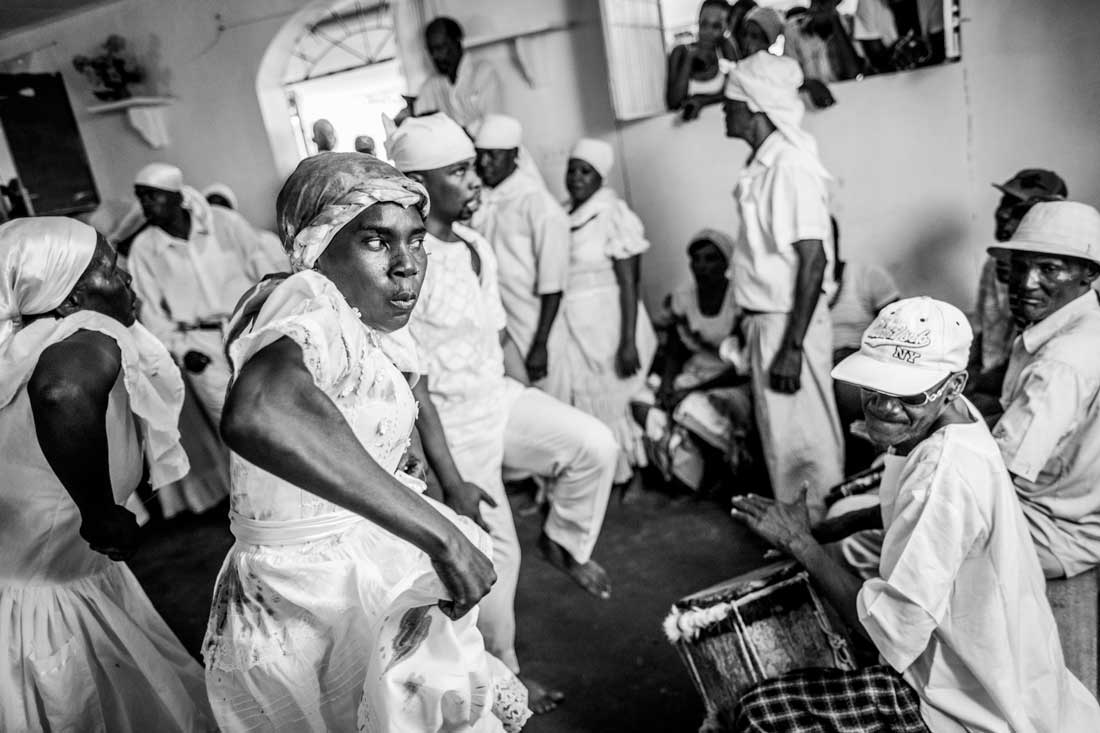
Drumming and dancing at a Vodou ceremony
Photo: Pierre Michel Jean
If you’re afraid of the devil or possession…
Put aside imagery from horror films like The Exorcist or associations of possession with demons. Instead, remember that people enter the possession trance willingly. No matter what happens, remember that Vodou is practiced to restore order, balance, health, and harmony in the lives of its followers.
Many non-practitioners both in Haiti and abroad have been taught to associate Haitian Vodou with evil, demonic possession and even satanism. This is rather silly and slanderous, as there is not even a satan figure in the Vodou pantheon of spirits who could be worshiped.
Vodou practitioners believe in a supreme god named Bondye or Gran Met who is all-powerful yet remains aloof. There is no devil counterpart to Bondye, and like the concept of “source” or “godhead”, he is not directly involved in human affairs. The multitude of lwa - spirits of the ancestors - serve as intermediaries, much more comparable to the saints of the Catholic church than demons.
Still afraid you might get spontaneously possessed? Read our article Haitian Vodou Revealed to learn why this won’t happen.
Animal sacrifice
To ask for good luck, the servants of the spirits may make a blood sacrifice. Animals like roosters, chickens, doves, pigs, and goats may be slaughtered during the ceremony. The offering can be more or less bloody depending on whether it is for a fiery Petwo bosu (bull) spirit offering compared to, say, a ceremony held in honor of the gentle rada Marassa twins.
For western travelers who have grown up aware of PETA campaigns and animal rights activism work, it may be difficult to fathom 5,000 year-old ancient rituals being practiced largely unchanged today. If you are concerned about your reaction to this ancient practice, ask for details in advance so you can decide whether or not to attend.
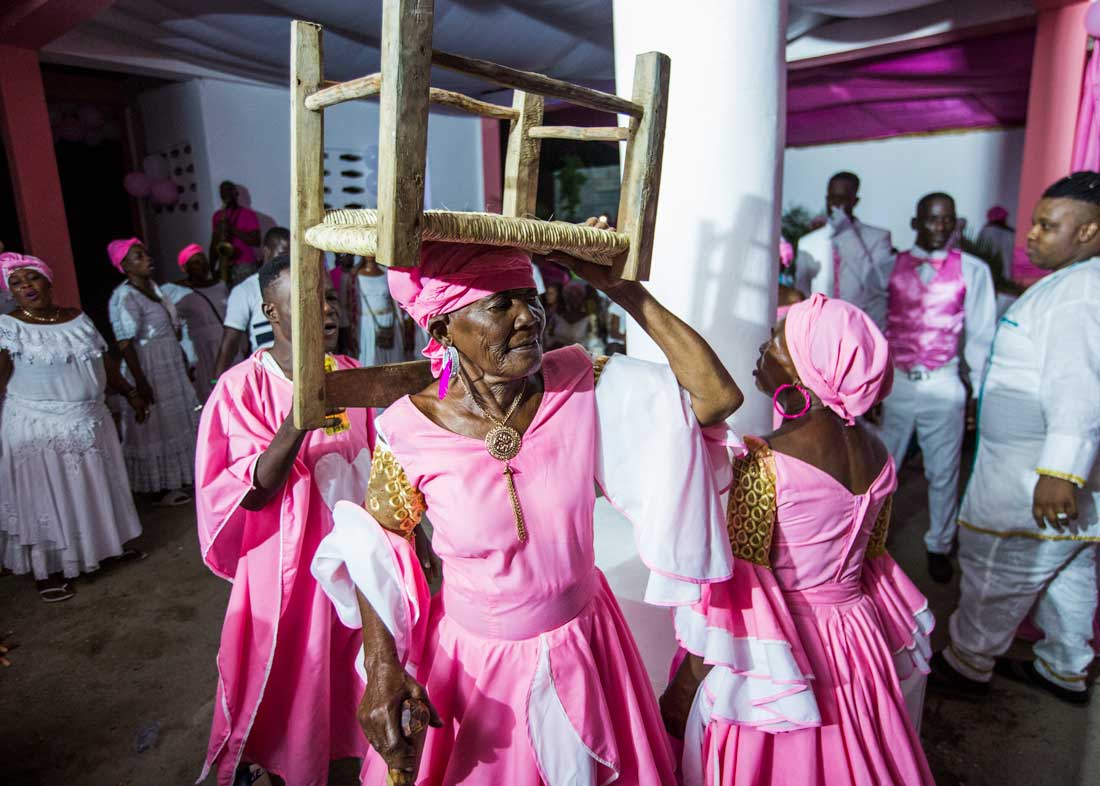
Women at a Vodou ceremony
Photo: Pierre Michel Jean
Do your homework
Haiti’s National Museum in Port-au-Prince is a great place to see some of the oldest, most historic Vodou drums - some date back to the 1500’s! The Musée du Panthéon National Haïtien (MUPANAH) is located on the Champs de Mars Boulevard and features a collection showcasing the heroes of the independence revolution, and the tools they used to found modern Haitian culture.
Just around the corner from the National Museum is the Bureau of Ethnology, a museum dedicated entirely to Haitian Vodou! If possible, do visit at least one of these museums prior to your Vodou ceremony experience.
LGBTQ+ and Safe Spaces
Cross-dressing, trans identies, and all gender expressions are welcome in Vodou communities. Same-sex relationiships and behaviour are often accepted without question. No one bats an eye - in this space, at least, these minority identities are respected as servants of the goddess of love, Erzulie. Expect the dance to be a safe space. You may see men in women’s dresses and much stranger things.
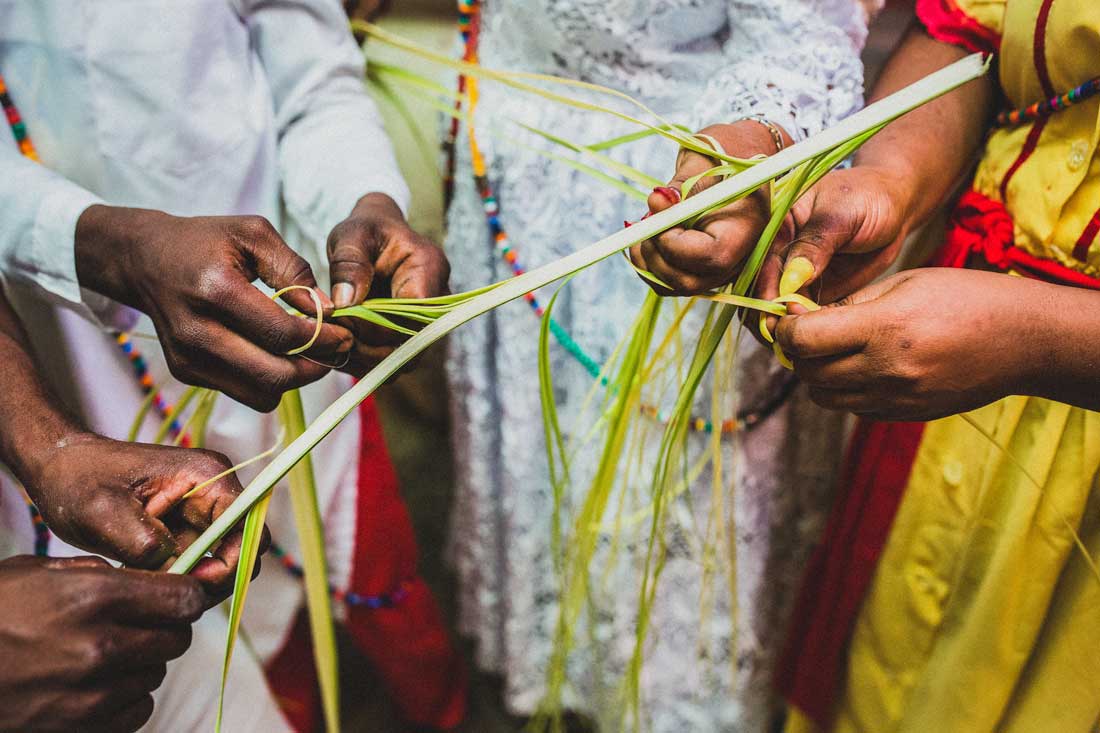
A 'Chire Aiyzan' ritual being performed during a Vodou eremony
Photo: Pierre Michel Jean
100% Vodou
The truth is, that even some Haitians who follow the Protestant or Catholic traditions and attend mass on Sundays can be found seeking advice from a mambo or ougan during the week. In fact, a popular bumper sticker in Port-au-Prince reads “Haiti, 80% Protestant 100% Vodouisan.” For outsiders, this widely-accepted practice can be hard to understand. Yet when a family member falls ill or life situations get dire, this faith-flexibility is common. It’s part of the complex syncretism of Haitian culture, where things are multi-layered and far richer in meaning than they often seem on the surface. Some people might go so far as to argue that you cannot truly understand Haitian culture until you have taken part in a Vodou ceremony.
At the end of the day, no matter your race, religion, sexual orientation or country of origin, you will be accepted with grace and warmth at a Vodou ceremony. Everyone is respected and the protection, good luck, and wishes for good health are extended to all who attend.
What do you say? Maybe it’s time to dance...
Explore Haiti's Art & Culture
Ciné Triomphe and Rex Théâtre
Ciné Triomphe and Rex Theatre are Haiti’s two major theaters,
9 Instagram Accounts That’ll Make You Want to Visit Haiti
Haiti is as Instagrammable as it gets, and here are
The broken heart of Port-au-Prince: Champ de Mars
A series of public squares divided by large boulevards, Champ
Rhythms and Rituals at Lakou Soukri’s Vodou Festival
Dive into the heart of Haiti with a journey to
Ten of the Best Books about Haiti
Cosy up with these ten books that explore the fascinating
Categories
Tags
Share
Subscribe to our newsletter
Get more travel inspiration, tips and exclusive offers sent straight to your inbox

